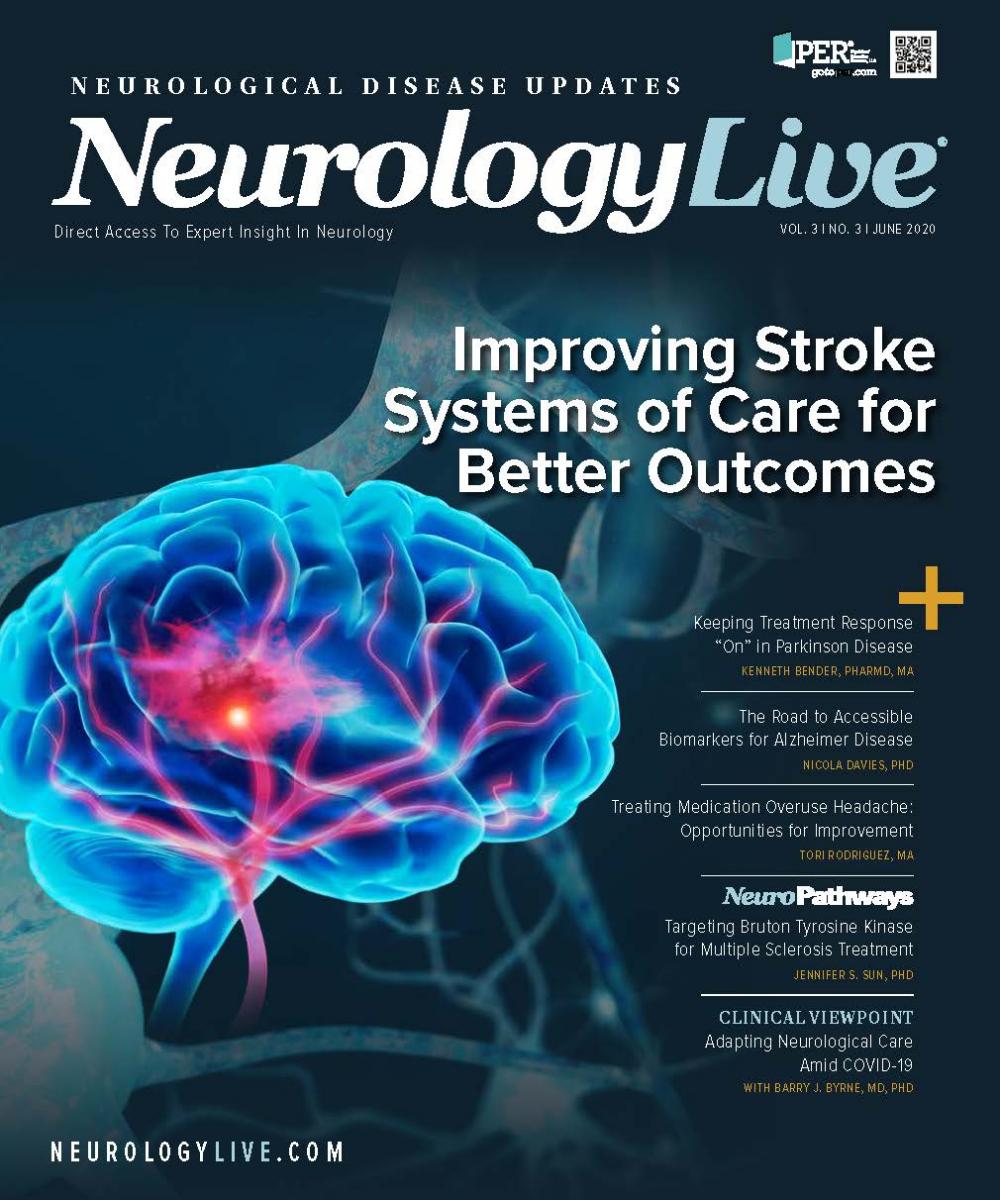Publication
Article
NeurologyLive
Stroke Care Evolves During These Uncertain Times
Author(s):
Andrew Russman, DO, guest editor for NeurologyLive, provides insight on how stroke care has changed during the COVID-19 pandemic.

Andrew Russman, DO
When we look back on changes in our lives during the novel coronavirus disease 2019 (COVID-19) pandemic, I hope we’ll remember how we confronted these challenges, adapted, innovated, and persevered. Resilience, whether individual or societal, can be an essential by-product of crisis.
During an initial surge in COVID-19 cases, neurologists reported 20% to 50% reductions in acute stroke imaging and clinical presentations to emergency departments (EDs).1,2 Among patients with COVID-19, multiple anecdotal cases of a variety of etiologies for stroke have emerged. Complications in patients with COVID-19 are being attributed to reported viral-induced thrombophilia,3 cardiomyopathy,4 and systemic inflammatory states5 that have affected this population.
Patients have expressed their uncertainty regarding the safety of presenting to the ED with stroke symptoms by staying home rather than seeking necessary emergency care. Patients’ self-selection from ED and hospitalized care has shifted an increasing burden of illness to outpatient management, with consequent delays in diagnosis and treatment. I have witnessed patients of mine who have suffered new acute stroke presentations and delayed their presentation to the ED until they were ineligible for thrombolytic therapy and could not manage their disability, out of fear of exposure to COVID-19.
Our dedicated cerebrovascular team of outpatient nurses, advanced practice providers, and physicians has spent considerable time reassuring patients and encouraging them to present to the ED so we can best care for their acute stroke.
An experience during the early stages of the COVID-19 surge in northeast Ohio illustrated the anxiety that prehospital providers experience when caring for patients with acute stroke. A patient with acute ischemic stroke and a negative COVID-19 symptom screen was transported on our mobile stroke unit. Immediately on arrival in the ED, he underwent a CT angiogram of the head and neck, which demonstrated ground-glass opacities concerning for viral pneumonia. Close exposure to a patient with suspected COVID-19 generates a variety of concerns among members of the health care team. Uncertainty regarding proper donning and doffing of personal protective equipment (PPE) and potential risk to self, patients, and family reach a crescendo during the uncertain interval while COVID-19 testing is pending.
In planning for the COVID-19 surge, I’ve spent countless hours developing new clinical workflows for the assessment of acute stroke symptoms in temporary hospitals we hope we will never need, restructured outpatient and inpatient clinician schedules to protect patients and providers, and designed staged redeployment plans for our stroke physician faculty. I have observed a significant increase in the efficiency of holding virtual faculty meetings but lamented the reduced banter among myself and my colleagues, as the usual exchange has always been for the betterment of our clinical and academic practice.
As a provider of telestroke services, I have learned a new appreciation for this capability and its timeliness in caring for patients during the COVID-19 pandemic. As a teaching physician and a section head for stroke services, I have had to develop new rounding practices and witnessed the impact on clinical care and trainee experience.
To reduce provider exposure risk, steward our PPE resources, and optimize clinical decision-making in the ED, we have employed a hybrid telemedicine model in our academic practice that uses a single neurological trainee at bedside with supervision from a vascular neurology fellow or staff member.
On stroke teaching rounds, we use a virtual meeting platform to present the patient history and physical, facilitate review of imaging, discuss clinical management, and review relevant literature. We have limited the number of team members who interact at the bedside and reduced redundant clinical examination for patients with suspected or confirmed COVID-19.
On an outpatient basis, we were already performing a small portion of our clinical visits using a virtual platform. With the emergence of the COVID-19 pandemic, we were challenged to rapidly shift the vast majority of outpatient services to virtual platforms to facilitate social distancing, reduce PPE use, and provide effective care for our patients. We have found new and innovative ways to conduct physical examinations through our virtual platforms. Patients have had to adapt their expectations of the virtual visit experience and manage previously unfamiliar application technology tasks using their smartphones. Hands-on outpatient rehabilitative care has suffered.
Stroke-related research involving COVID-19 has flourished with numerous anecdotal experiences, case reports, and case series popping up in the literature, reflecting the stroke community’s commitment to tackle the beast of uncertainty surrounding clinical management of acute stroke in patients with COVID-19. However, research involving patients without COVID-19 has suffered, with many important clinical trials being put on hold1,6 and institutional review boards delaying expedited review of minimal-risk, non—COVID-19–related research.
Stroke systems of care are rapidly evolving to meet the challenges of the COVID-19 pandemic. As we slowly emerge from stay-at-home orders, restart office clinical practices, and perform elective procedures, we must advocate for our patients by telling them what they don’t know—EDs and hospitals are safe for patients, and acute stroke needs to be managed emergently to reduce disability and prevent complications. I appeal to my neurology colleagues throughout the world: Engage with your local print and television media, tweet your support and post on other social media, make an impassioned video appeal, start a blog, and otherwise get the word out to patients with stroke that there is no time like the present to seek our care and expertise and confront their fears with our help, rather than doing harm to themselves by ignoring it.
REFERENCES
1. Leira EC, Russman AN, Biller J, et al. Preserving stroke care during the COVID-19 pandemic: potential issues and solutions. Neurology. Published online May 8, 2020. doi:10.1212/WNL.0000000000009713
2. Kansagra AP, Goyal MS, Hamilton S, Albers GW. Collateral effect of Covid-19 on stroke evaluation in the United States. N Engl J Med. Published online May 8, 2020. doi:10.1056/NEJMc2014816
3. Tang N, Li D, Wang X, Sun Z. Abnormal coagulation parameters are associated with poor prognosis in patients with novel coronavirus pneumonia. J Thromb Haemost. 2020;18(4):844-847. doi:10.1111/jth.14768
4. Madjid M, Safavi-Naeini P, Solomon SD, Vardeny O. Potential effects of coronaviruses on the cardiovascular system: a review. JAMA Cardiol. Published online March 27, 2020. doi:10.1001/jamacardio.2020.1286
5. Zhang Y, Gao Y, Qiao L, Wang W, Chen D. Inflammatory response cells during acute respiratory distress syndrome in patients with coronavirus disease 2019 (COVID-19). Ann Intern Med. Published online April 13, 2020. doi:10.7326/L20-0227
6. Meschia JF, Barrett KM, Brown RD, et al. The CREST-2 experience with the evolving challenges of COVID-19: a clinical trial in a pandemic. Neurology. Published online May 1, 2020. doi:10.1212/WNL.0000000000009698





